 |
 |
Lutz Becker
Lutz Becker is a filmmaker, artist and curator. Born in Berlin, he has lived and worked in London for most of his adult life. He is of a generation still affected by the aftermath of the WW2, the rebuilding of Germany and the student’s revolt of the late 60s. His films, videos and curatorial projects have been shown internationally. His paintings are in institutional and private collections.
As a student in London, Lutz Becker embraced the forward looking spirit of abstraction and artistic internationalism. This led him towards the painterly procedures of informel. He got interested in the synthetic sound structures of electronic music which lead him towards the making of experimental abstract films at the BBC. His preoccupation with movement and time influenced much of his film and video work.
Becker is a director and producer of political and art documentaries such as Double Headed Eagle, Lion of Judah and Vita Futurista to name a few as well as TV productions, such as Nuremberg in History. He participated as an artist in the First Kiev Biennale in 2012 with the video installation, The Scream, and is currently preparing the reconstruction of Sergei Eisenstein’s film Que viva Mexico!.
In addition to Lutz Becker’s work as artist and film maker, he is also a curator, specialising in Russian Constructivism and Italian Futurism. He curated for Tate Modern the Moscow section of Century City (2001); for the State Museum of Modern Art, Thessaloniki, Construction: Tatlin and After (2002); for the Estorick Collection, London, a survey of European photomontage Cut & Paste (2008); for Kettle’s Yard, Cambridge, a show of 20th Century drawings Modern Times: Responding to Chaos (2010). Most recently he co-curated Solomon Nikritin – George Grosz, Political Terror and Social Decadence in Europe between the Wars at the State Museum of Modern Art, Thessaloniki.
After the wall
1999/2014, Limited Edition Vinyl Record, 39 min 46 sec
1999/2014, Sound Sculpture on loop, 37 min 18 sec
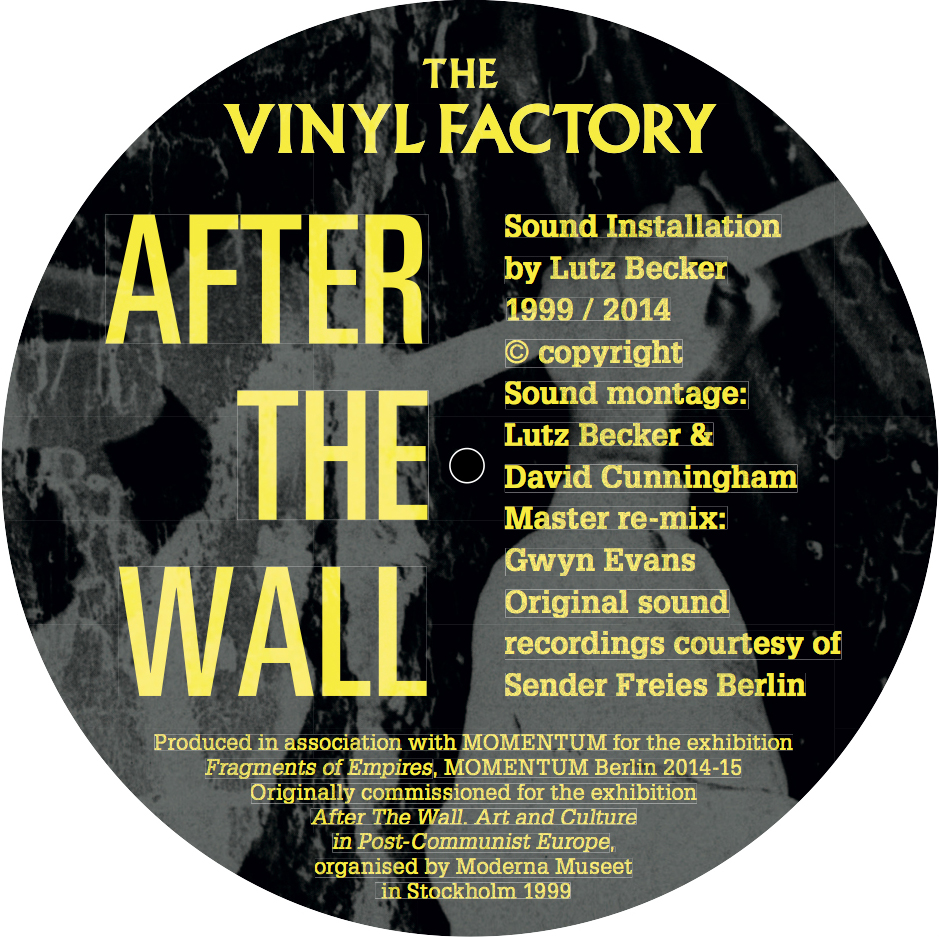
Lutz Becker’s sound sculpture, After the Wall, re-visits a sound installation commissioned for the exhibition After the Wall held at the Moderna Museet Stockholm in 1999, curated by David Elliott. Its five constituent sound montages are based on original recordings made at the fall of the Berlin Wall. After its installation in Stockholm it travelled subsequently to Budapest and Berlin. MOMENTUM originally presented the sound sculpture After the Wall in our exhibition Fragments of Empires in the context of the 25th anniversary of the fall of the Berlin Wall in 2014. Together with The Vinyl Factory, we also produced a limited edition vinyl record of After the Wall. This work was subsequently acquired by the MOMENTUM Collection. The soundscapes captured in After the Wall – a discordant cacophony of hammering and banging – are derived from the recorded sounds of thousands of people across Berlin wielding hammers and chisels to break down the Wall.
The fall of the Berlin Wall in November 1989, symbolised the end of the separation of the City of Berlin, as well as that of Germany into an Eastern and a Western state. It marked, for everybody to see, the final collapse of Communism. It was a moment in history that promised to the people of Germany and other Europeans a new beginning. The significance of the Berlin Wall extended far beyond the city, beyond the borders of Germany. It epitomised the Cold War confrontation between the Warsaw Pact and the NATO alliance. The Wall separated the spheres of interest between Communism and Capitalism. On 13. August 1961 the government of East Germany, the GDR, began to seal off East Berlin from West Berlin by means of barbed wire and anti-tank obstacles. The underground and railway services of Greater Berlin were severed and West Berlin was turned into an island within GDR territory. A solid wall gradually replaced the provisional fence. It was made up of concrete segments of a height of 12 feet and was 165 miles long. A trench ran parallel to it to prevent vehicles from breaking through. There was a patrol corridor behind it, watch towers, bunkers and electric fences.
It appeared to the population of Germany that the split of their country and of Berlin would last forever. In 1989, as a reaction to Gorbachov’s reforms in the Soviet Union and massive unrest in their country, the government of the GDR decreed the opening of the Wall on 9. November 1989. In the following days and months demolition workers began with tearing it down. On 1. July 1990 the GDR gave up her statehood and merged with West Germany. For the Germans the demolition of the wall was an act of liberation. It gave hope for a future in which unhindered communication and freedom of movement would be everybody’s natural right. Within days of the ‘opening’ of the wall its terrifying symbolism lost its power. Millions of people came to Berlin to look at the now defunct wall and to take a piece of it with them to remember this moment of history. Hundreds of people attacked the graffiti covered surfaces of the Wall, eroding it bit by bit. The so called ‘Mauerspechte’, wall-peckers as opposed to woodpeckers, worked on the Wall day and night; their hammering, knocking and breaking sounds travelled along the many miles of Wall. The high-density concrete of the structure worked like a gigantic resonating body; its acoustic properties created eerie echoes driven by the random percussion of the hammering.
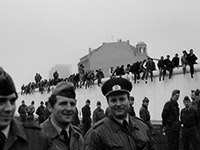 |
AFTER THE WALL – Potsdamer Platz
|
|||
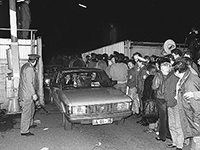 |
AFTER THE WALL – Invalidenstrasse
|
|||
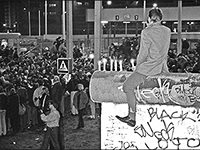 |
AFTER THE WALL – Checkpoint Charlie
|
|||
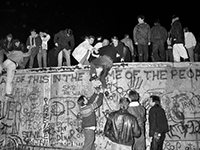 |
AFTER THE WALL – Brandanburger Tor
|
|||
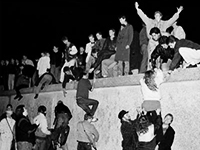 |
AFTER THE WALL – Night
|


 Back to Index
Back to Index